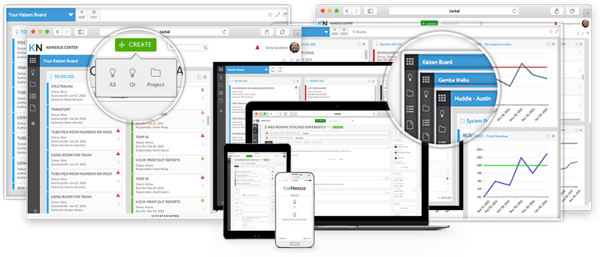 McKinsey and Company, one of the country’s leading management consultancies, reports that up to 70% of systemic change programs fail to reach their business goals.
McKinsey and Company, one of the country’s leading management consultancies, reports that up to 70% of systemic change programs fail to reach their business goals.
Why? According to the firm, “Common pitfalls include a lack of employee engagement, inadequate management support, poor or nonexistent cross-functional collaboration, and a lack of accountability. Furthermore, sustaining a transformation’s impact typically requires a major reset in mind-sets and behaviors—something that few leaders know how to achieve.”
What these challenges all have in common is that they revolve around the way people think about change. Creating a culture that values process improvement requires a transformation in how leaders behave and how engagement is recognized and rewarded.
Here are five things you can do to increase engagement and accelerate the pace of positive change in your organization.
Adopt a People-First Approach
Every initiative should have a champion, but it might not be one of the usual suspects. The most effective advocates for change are people who are directly impacted by the problem to be solved. They are good communicators who can explain to others what’s in it for them. One’s place on the org chart is far less important than their commitment to improvement that leads to better results.
When you identify people who can inspire action from others, invest in their development. Reframe the idea of change from something that “happens to” employees to something that happens because employees take action to positively impact how their work gets done. Build the confidence of your influencers so they can take the lead in bottom-up improvement.
Exercise Trust
Asking someone to lead a process improvement project is one thing; trusting them to do it is another. However, if you maintain a tight grip on positive change, you become the bottleneck that slows the rate of improvement. On the other hand, if you empower people and give them the tools they need, leaders can get out of the way and support change, rather than control every aspect of it.
Process management software plays an important role. With technology in place, not only can more people participate in improvement in a structured and consistent way, but also managers can track the progress of projects and ensure forward momentum without micromanaging people. Executive dashboards let leaders know what’s going on and develop confidence that activities are aligned with strategic goals.
When people feel they have ownership of a process or a project, they invest emotionally in the outcome and are more likely to go the extra mile to achieve the stated goals. They shift from carrying out an assignment to working toward a desired outcome.
Demonstrate that Improvement is a Priority
No business leader would say they don’t want improvement. Of course, they do, but surprisingly few make room for people to engage in positive change. What does that look like?
For starters, it means investing in training for people at every level of the organization. The ability to spot an opportunity for improvement and act on it is not innate in most people. Coaching around change should include:
How process improvement aligns with the most important goals of the organization
- What benefits employees will gain through improvement projects
- Examples of past successful process improvements
- How to leverage improvement management software to define and implement improvement projects
Once people have the skills to identify and act on improvement opportunities, they will need the time. If employees are so busy fighting fires and managing broken processes, change will take a back seat. That’s why it is vital to carve out time to give employees the chance to think about how things could be better, decide what steps to take, and experiment with new solutions.
Make it Easy to Engage
Sometimes people do get involved in positive change because they don’t have the tools or information they need at their disposal. This should be an important consideration when you consider which process management technology to use. Any solution you consider should be accessible to everyone.
Choose a platform that supports remote teams and multiple devices. If you have employees who do not have computer workstations, such as retail or factory workers, you may consider a kiosk or other method of making improvement software available. Wallboards or other displays that put improvement work front and center are also a useful approach.

Place a High Value On Collaboration
Collaboration is an essential element of positive change because many opportunities for improvement exist at functional intersections. Cross-functional teams also bring fresh eyes and new perspectives to problems that may appear to be intractable to the people who deal with them every day.
Another way to look at collaboration is that leaders are in a partnership with process operators that seek better results for all stakeholders. Consistent communication and open feedback are essential in developing this partnership.
Obviously, we think improvement management technology is a critical element of any change management program, but it won't get results without well-informed and motivated team members. That’s why it is essential to focus on what you can do to center your approach around the people who will make it a success.
![[Watch Now] Bottom-Up Improvement](https://no-cache.hubspot.com/cta/default/326641/804fb6fa-7d09-4472-9c33-824363af1f8a.png)



Add a Comment